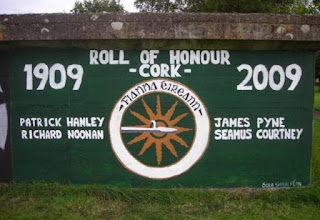High winds and heavy rain swept through Cork city on the night of November 17th 1920 when bloodshed soaked the Marsh area.
This working class area around the St Francis church teemed with tenements and hived with republican activity.
At 11:45pm two RIC men left their barracks on Tuckey Street and ventured into the Marsh area to carry out a night of murder and mayhem.
Broad Street in the early 20th century.
Earlier that evening Sergeant James O'Donoghue of Tuckey Street barracks was shot dead by the IRA on White Street. His enraged fellow policemen sought revenge and did so under the cover of darkness that night.
Broad Street in the early 20th century.
Earlier that evening Sergeant James O'Donoghue of Tuckey Street barracks was shot dead by the IRA on White Street. His enraged fellow policemen sought revenge and did so under the cover of darkness that night.
The strange thing is, Srgt O'Donoghue often found himself at odds with his fellow RIC men, especially those newly recruited into the Auxiliary Division. He hated their thuggish behavior and he was on friendly terms with members of the local Republican movement, infact his killing was not sanctioned by the IRA and those who carried it out were condemned by senior IRA officers.
Due to curfew no street lamps lit the streets of Cork and the two RIC men found their way to the Broad Street tenements with flash lamps. Wearing long over coats and goggles, they burst in through the door of no.2 Broad street and began shooting in the Coleman family dwelling. Stephen Coleman was shot but survived.
Patrick Hanley was a member of Fianna Eireann and he was laid out in Saint Peter and Paul's church in his uniform as his comrades formed a guard of honour for his funeral. He was laid to rest in the Republican plot in St Finbarrs cemetery.
When the two RIC men finished their deed in no.2 Broad street they casually walked around the corner to no. 17 Broad Lane. They kicked in the door and shot 16 year old Charles O'Brien, another Fianna scout.
The RIC men then ran upstairs where they kicked in the door of the Hanley's home and encountered 17 year old Patrick Hanley in his bed. Young Hanley put up his hands, asked the policemen not to shoot and informed them he was the sole bread winner in his family for his widowed mother and sisters. The RIC men raised their revolvers and a bullet pierced Hanley above his heart, killing him instantly.
Memorial picture for Patrick Hanley.
Witness account from the military archives
Grave of Patrick Hanley, St Finbarr's Republican plot.
O'Brien was hit in the face by a bullet which would leave him disfigured for life. He lost an eye, part of his jaw and recovered in secret at the nearby Mercy hospital. Upon his discharge after several months he did so in secret, leaving the hospital inside a laundry basket!
Modern day Broad Street, very different from what it was 100 years ago.
After shooting young O'Brien the callous RIC men then encountered 28 year old Eugene O'Connell on the landing and fired at him. A bullet struck O'Connell but he managed to crawl back into his room where his wife was in bed with their baby.
Modern day Broad Street, very different from what it was 100 years ago.
After shooting young O'Brien the callous RIC men then encountered 28 year old Eugene O'Connell on the landing and fired at him. A bullet struck O'Connell but he managed to crawl back into his room where his wife was in bed with their baby.
The RIC men followed O'Connell and fired more bullets into him, killing him, then one of them raised their revolver at O'Connell's wife who was screaming, along with her baby, in bed. They hesitated before deciding to spare Mrs O'Connell her life. When leaving no.17 Broad Lane, the policemen flung a bomb into its entrance, injuring another occupant, Mr Collins.
unveiled in 1957 by the Lord Mayor of Cork at Hanley Buildings, Grattan Street, a plaque commemorating Patrick Hanley.
O'Connell was an IRA Volunteer with the First Cork brigade but had served with the Munster fusiliers during WWI. He was buried in St Joseph's cemetery.
Nobody was brought to account for the night of terror in the Marsh. The tenements are no more, but a plaque commemorates Patrick Hanley on the site where a November night brought murder and mayhem to the area. It is, to date, the only plaque to mark that dark night in 1920.
unveiled in 1957 by the Lord Mayor of Cork at Hanley Buildings, Grattan Street, a plaque commemorating Patrick Hanley.
O'Connell was an IRA Volunteer with the First Cork brigade but had served with the Munster fusiliers during WWI. He was buried in St Joseph's cemetery.
Grave of Eugene O'Connell.
Maud Gonne MacBride visiting the scene of the Broad Street Massacre.
Mural at Cork's Lee Fields, later removed by Cork Council.
Nobody was brought to account for the night of terror in the Marsh. The tenements are no more, but a plaque commemorates Patrick Hanley on the site where a November night brought murder and mayhem to the area. It is, to date, the only plaque to mark that dark night in 1920.





















No comments:
Post a Comment